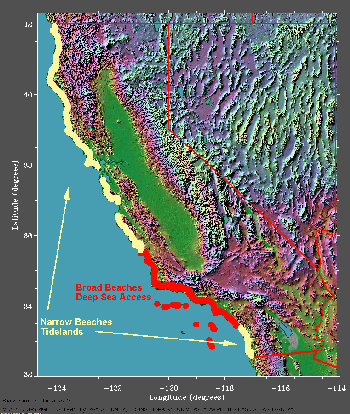 The Pacific Coast
The Pacific CoastThe entire Pacific Coast is a distinctive ecological region whose main attributes are the weather patterns and food resources determined by the ocean. Geology combines with these factors to mold the coastline itself. Thus, there are two main divisions of the coast. In both the north and the south, the coastline tends to be rugged cliffs with narrow rocky beaches. It was difficult for humans to appropriate all of the ocean's resources in this situation, and people tended to utilize what they could find in the tidelands and surf or on the near-lying sea stacks. In a unique portion of coastline in between (though not in the state's middle), the coastline tends to be more gentle terrain, including river floodlands such as the outlet of the Santa Ynez River or broad sandy beaches such as those from Malibu south to Redondo Beach. These beaches were also protected from the prevailing NW swells of the ocean so it was possible to launch larger canoes. Here, people appropriated all of the ocean's resources, including deep sea fish and mammals; ocean-going Indians even traveled to distant islands, twenty to thirty miles off the coast.
Return to previous page.